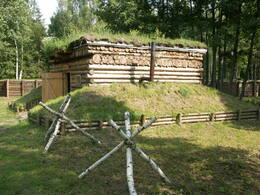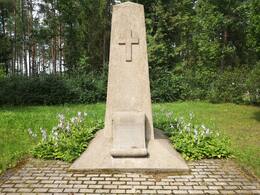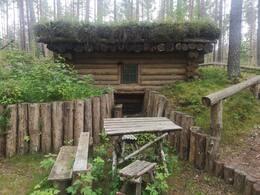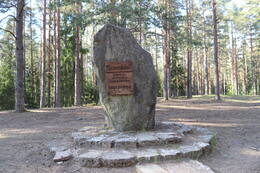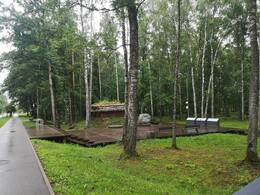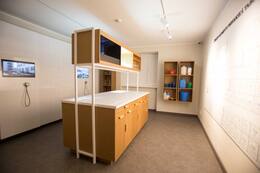Creation of defensive positions.
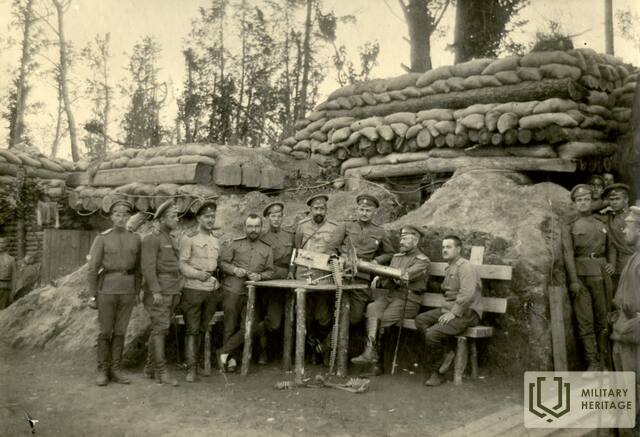
The description looks at the battlefield fortification in general. It is based on the experience of the First World War and the situation when it is necessary to organize extensive work on the fortifications.
"(..) During this time of war, a soldier must be able to handle a shovel in the same way as a rifle. If a soldier is successful, it is necessary to immediately harden with a shovel, despite the fatigue. In the field war, each part of the army must be able to build excavations on its own, why it is necessary to know the principles of fortification and excavation, as well as the organization of work. (..) ”
“(..) All foreign armies in each infantry regiment have sapper or pioneer teams or ornaments. To distinguish infantry sappers from technical troop sappers, some countries refer to infantry sappers as pioneers, as we will call them. The task of the pioneers in the infantry is to perform tasks that the infantry is not able to do for some reason, such as mining the fields, doing simple blasting, building earthworks, reinforcing basements, preparing camouflage nets and paints, etc. regiment and battalion, give their assessment and present a construction plan and work plan to the regiment or battalion commander. Pioneer officers can also be assigned to supervise fortifications and reprimands, distribute tools and materials to be carried. Pioneer officers, however, must not interfere with or interfere with infantry. Disputes are always resolved by the commander of the regiment or battalion. In all major countries, there is a sapper or engineering battalion at each division, consisting of 2-3 sapper jewelry and an engineering park. In the smaller countries, which are not so rich and cannot afford to buy a lot of technical equipment, each division has a sapper company and an engineering park. Sapiers are divided into various specialties, such as bombers, carpenters, miners, pontoons, camouflage, etc. Sapiers must support infantry in battle for fortified positions, intelligence, overcoming obstacles and strikes. Sapper receives orders from infantry superiors. Sapiers agree with the most difficult technical works that infantry cannot perform, such as: construction of column roads in difficult areas, construction and maintenance of bridges, construction of minefields, blasting, mining of galleries, etc. In richer countries, metal demountable bridges are being prepared in peacetime, which can be installed in a short time and overloaded with heavy loads. (..) ”
Description of equipment. No.3. 1927. Fortification of the battlefield.
Related timeline
Related objects
Christmas Battle Museum
The museum is located in “Mangali” house, Valgunde Ru ral Territory, Jelgava Municipality, and it is a branch of the Latvian War Museum. It was unveiled in 2005 at the site of the Christmas Battles that occurred during World War I. Unique World War I fortifications still remain at the battle sites. The open-air exhibition of the Christmas Battle Mu seum reconstructs a section of the fortification system – the trench shelter and part of the first line of German defence – the “German rampart”, which is the only object of this kind in the Baltic states. The Christmas Battles are one of the best known and most dramatic events of World War I in Latvia. They are an event of special importance in Latvian military and cultural his tory. Intense fighting took place for six days, leading to heavy casualties. The battles are mainly associated with the attack of Latvian Riflemen against the German Army units, which took place in particularly severe and unfa vourable winter conditions. This is an unprecedented case of a major combat operation launched without artillery support. Today, the museum artefacts found at the sites of the bat tle are on display. The indoor exhibition is open at certain times, while the exhibition of outdoor fortifications is open every day. Tourist routes and nature trails have been cre ated in the surrounding area.
Christmas battles memorial at Antinu Brethren Cemetery
Located in Babīte district, on the side of the road near the former Antiņi house and the old medicine warehouse.
The cemetery of Antiņi or Tīreļi soldiers was established during the First World War. The defense positions of the army of the Russian Empire were located in the area. In 1917, during the Christmas battles, the headquarters of the 5th Zemgale Latvian Rifle Regiment and an infirmary with a medicine warehouse were located nearby.
In the night of January 5, 1917, in the light of eight huge bonfires, 105 fighters of the 5th Zemgale Latvian Rifle Regiment were buried in military honor. They fell in battle against the German army or died from injuries. The funeral ceremony was led by Regiment Commander Jukums Vācietis. In later years, soldiers from other units of the Russian army were also buried in the cemetery. In 1925, a monument to the architect Eizen Laube was unveiled in the cemetery, and the territory was landscaped. Information about the 3,800 soldiers buried in the cemetery can be found in many places, but it must be assessed as unlikely and unverified.
Latvian riflemen positions and trenches in Tīreļi
Latvian Riflemen dugouts and trenches in Tīreļi are located in Babīte parish, Mārupe municipality, in the vicinity of the Antiņi Latvian Riflemen Cemetery and the former medicine warehouse. During World War I this was the defensive position of Latvian Riflemen of the Russian Imperial Army. A complex of trenches and surface dugouts was built in the sandy hills. Trench or positional warfare is the best way to accurately describe World War I and emphasise the importance of fortifications. They were based on the research of military engineers and adapted to the environment and the development of new weapons. The everyday life of a soldier is a continuous improvement of defensive fortifications. Sometimes soldiers would give the dugouts names that reminded them of their homes and would help to forget about the reality of the war. Trench lines were complex defensive systems that were hard for the enemy to take. With the development of weapons these defences became even more sophisticated. The roofs of dugouts were reinforced to withstand artillery shells. Trenches were made in changing patterns and directions so that explosions would cause as little damage as possible. Movement passages had pockets that were used as short-term hiding spots during artillery fire, because they protected soldiers from shrapnel and rubble. Today part of the fortification has been restored and you can visit 3 restored dugouts and a 100 m long section of the trenches.
Ložmetējkalns (Machine Gun Hill) in Tīreļpurvs Bog
Ložmetējkalns is located in Valgunde Rural Territory, Jelgava Municipality, close to the A9 motorway. It is the site of a World War I battle and the only cultural heritage conservation site of national importance in Latvia. Ložmetējkalns is located on Garā Kāpa Dune, which is a part of the Nordeķi-Kalnciems dune ridge. The name originated at a time when it was the site of impregnable fortifications of the German Army, which was defended by heavy machine-gun fire. The Christmas Battles are one of the best-known and most dramatic events of World War I in the history of Latvia. In 1917, the units of Latvian Riflemen and Siberian riflemen of the Russian Army attacked and took Ložmetējkalns, capturing at least 600 enemy troops and valuable trophies. The riflemen believed that they were the ones who deserved the honour of captors of the highlands. The area around Ložmetējkalns Hill is home to commemora tive marks and other evidence of the battles that took place here. Every year, in January, memorial events are held in the surroundings of Ložmetējkalns to remember the Christmas Battles. Nowadays, Ložmetējkalns has become a symbol and a memorial site dedicated to the heroism of Latvian Riflemen. A 27-metre-high observation tower offers panoramic views of the site of Christmas Battles.
WWI Historical Exploration Route and dugout
Located in Olaine, near the Olaine Museum of History and Art.
The historical route was established in 2018 at the site of the fortifications of the Russian army during World War I, which were part of the defense system of the area. The fighting between the German and Russian armies in the Olaine area attracts attention for several reasons. The marshy terrain prevented the warring parties from making rapid progress and required a variety of skills from the soldiers to operate in adverse conditions. Accurate terrain analysis, reconnaissance, and fortifications or engineering structures played an important role in the war.
Nowadays, the cognitive route is freely available and gives a rough idea of the living conditions of soldiers. The renovated buildings are closed, but can be seen by contacting the specialists of the Olaine History and Art Museum in advance.
Olaine History and Art Museum
The exhibit in the Olaine History and Art Museum is about the period of Soviet occupation in Olaine. A World War I exploration route with restored elements of the fortifications has been created in the territory of the museum. On the site, where the World War I Russian Army defence line once was, a Russian soldier-type dugout has been built and a fragment of a shooting tower can be viewed by visitors. A World War I reinforced concrete fortification can be seen in Jaunolaine, at the intersection to Plakanciems. During World War I, active battles were fought between the Russian and German armies in this area. Latvian Riflemen units were involved in intelligence and various other operations. Marshy lands made it difficult to defend, but this was a very important area in Latvian military history. Olaine was formed due to the convenient location between Jelgava and Riga, where Jaunolaine is currently located. The Olaine manor was nearby. The modern day Olaine was built during the Soviet occupation, when industrial companies began their operations there.





